Norovirus Infection: Control and Risk Assessment in Aged Care Setting
VerifiedAdded on 2023/06/18
|10
|2785
|404
Report
AI Summary
This report provides a comprehensive analysis of norovirus infection control within a residential aged care setting. It defines norovirus, explains its transmission model, and analyzes the specific risks it poses to older individuals, particularly focusing on a 75-year-old resident with mobility issues. The report identifies essential infection control precautions, such as hand hygiene and food safety, and evaluates various risk assessment types, including qualitative, site-specific, dynamic, and cultural risk assessments. It also identifies key healthcare team members beyond nursing staff, such as geriatricians and podiatrists, who are crucial in resident care. The conclusion emphasizes the high risk of infection in residential care and the importance of implementing preventive measures to manage norovirus outbreaks effectively. Desklib offers solved assignments and study resources for similar topics.
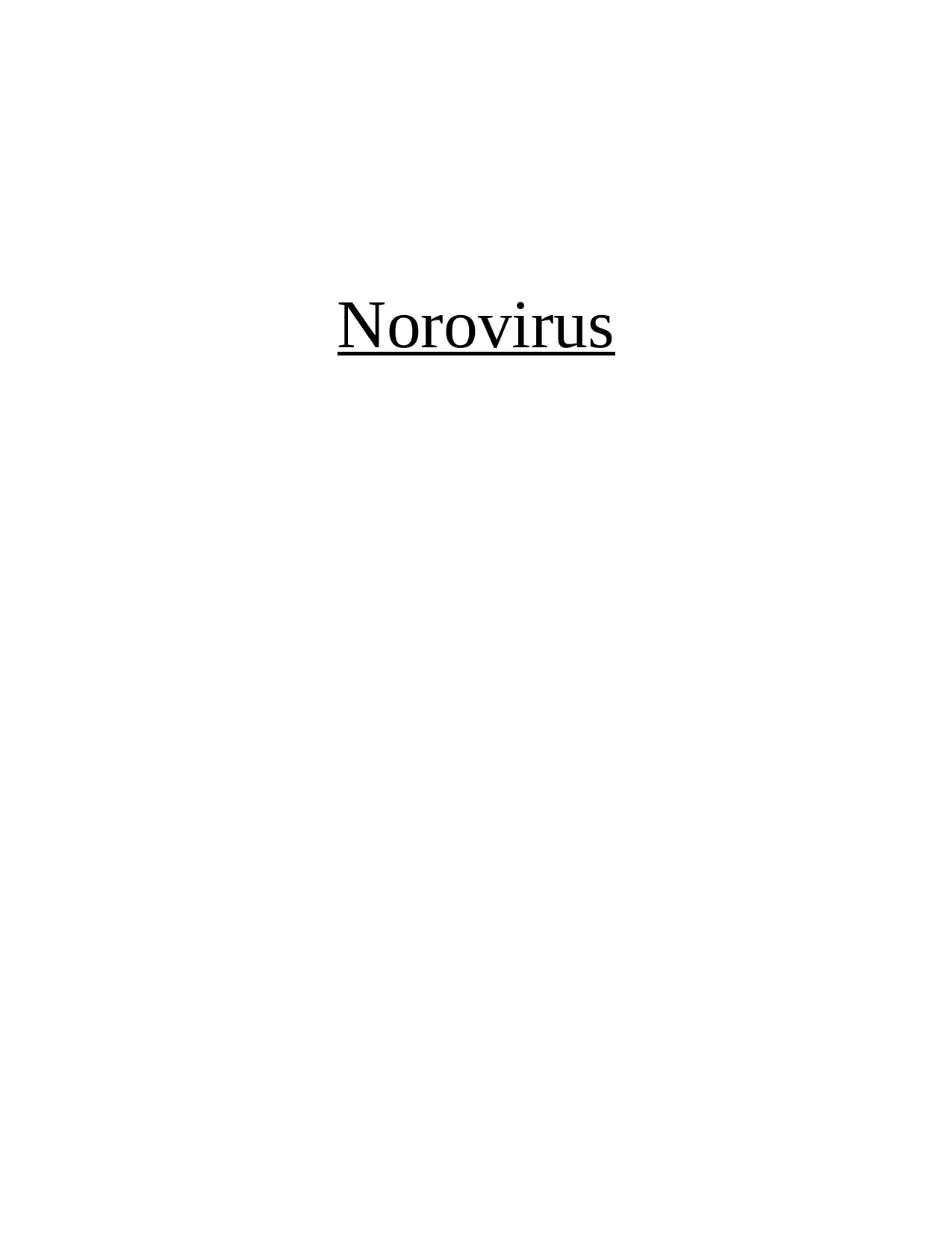
Norovirus
Paraphrase This Document
Need a fresh take? Get an instant paraphrase of this document with our AI Paraphraser
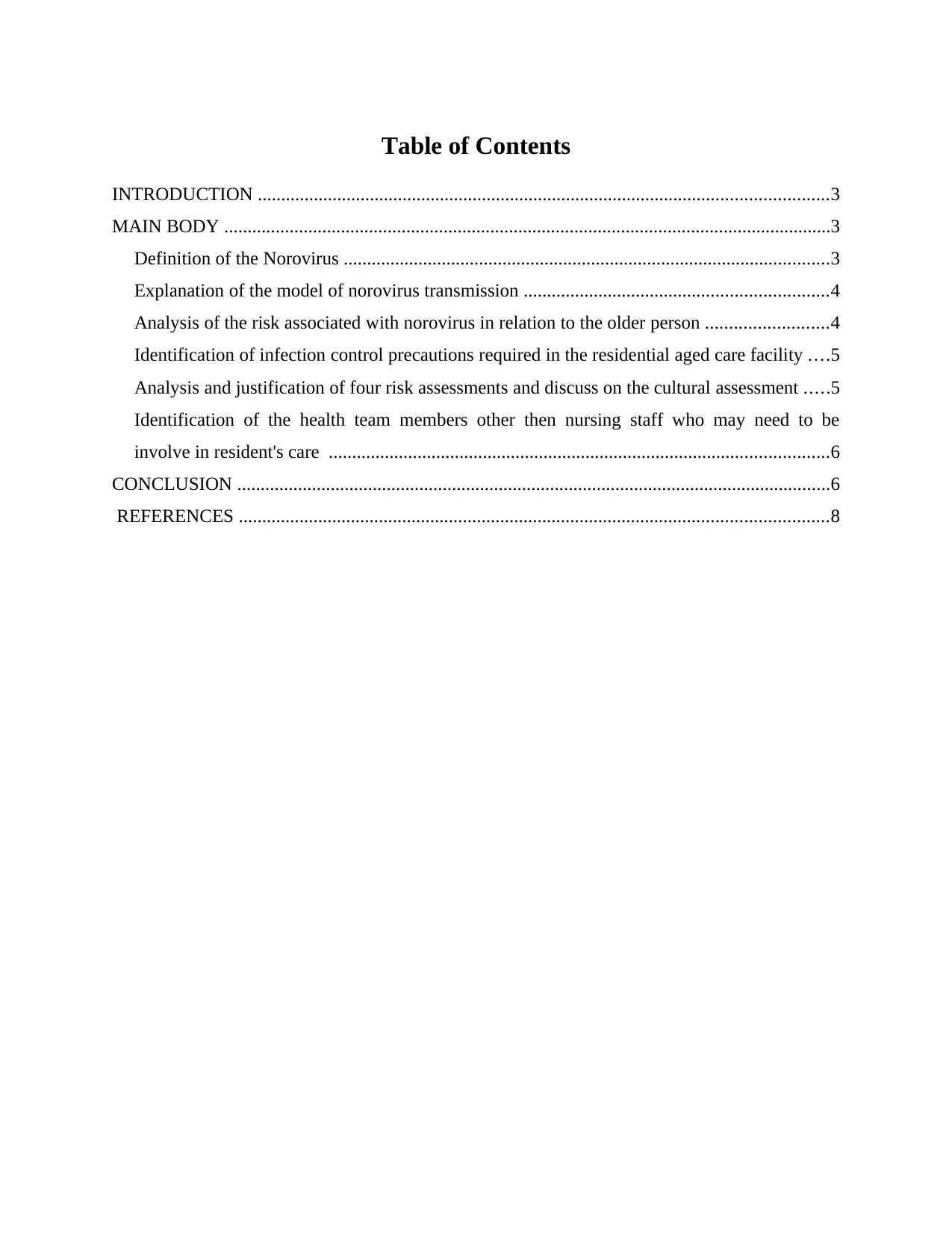
Table of Contents
INTRODUCTION ..........................................................................................................................3
MAIN BODY ..................................................................................................................................3
Definition of the Norovirus ........................................................................................................3
Explanation of the model of norovirus transmission .................................................................4
Analysis of the risk associated with norovirus in relation to the older person ..........................4
Identification of infection control precautions required in the residential aged care facility ....5
Analysis and justification of four risk assessments and discuss on the cultural assessment .....5
Identification of the health team members other then nursing staff who may need to be
involve in resident's care ...........................................................................................................6
CONCLUSION ...............................................................................................................................6
REFERENCES ..............................................................................................................................8
INTRODUCTION ..........................................................................................................................3
MAIN BODY ..................................................................................................................................3
Definition of the Norovirus ........................................................................................................3
Explanation of the model of norovirus transmission .................................................................4
Analysis of the risk associated with norovirus in relation to the older person ..........................4
Identification of infection control precautions required in the residential aged care facility ....5
Analysis and justification of four risk assessments and discuss on the cultural assessment .....5
Identification of the health team members other then nursing staff who may need to be
involve in resident's care ...........................................................................................................6
CONCLUSION ...............................................................................................................................6
REFERENCES ..............................................................................................................................8
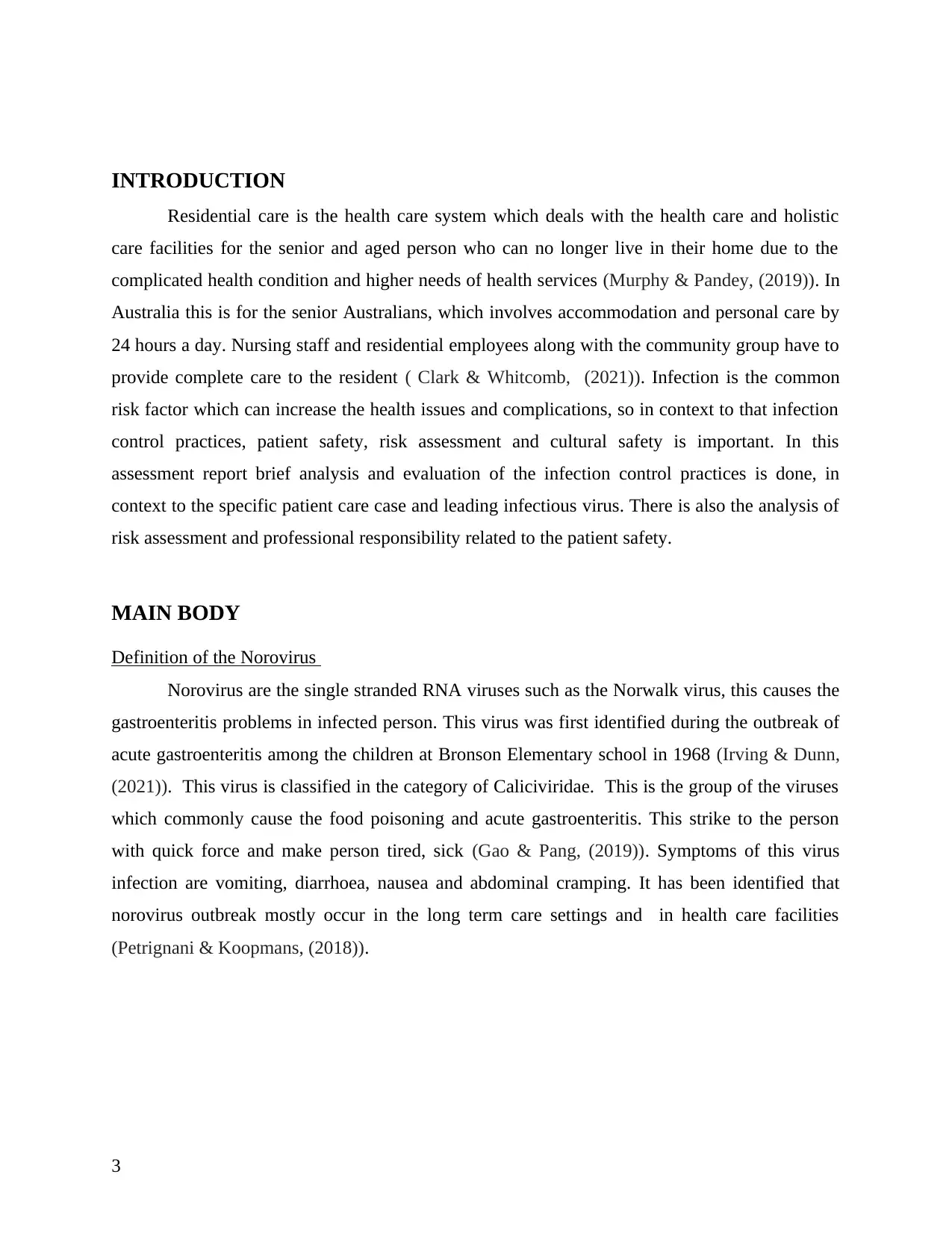
INTRODUCTION
Residential care is the health care system which deals with the health care and holistic
care facilities for the senior and aged person who can no longer live in their home due to the
complicated health condition and higher needs of health services (Murphy & Pandey, (2019)). In
Australia this is for the senior Australians, which involves accommodation and personal care by
24 hours a day. Nursing staff and residential employees along with the community group have to
provide complete care to the resident ( Clark & Whitcomb, (2021)). Infection is the common
risk factor which can increase the health issues and complications, so in context to that infection
control practices, patient safety, risk assessment and cultural safety is important. In this
assessment report brief analysis and evaluation of the infection control practices is done, in
context to the specific patient care case and leading infectious virus. There is also the analysis of
risk assessment and professional responsibility related to the patient safety.
MAIN BODY
Definition of the Norovirus
Norovirus are the single stranded RNA viruses such as the Norwalk virus, this causes the
gastroenteritis problems in infected person. This virus was first identified during the outbreak of
acute gastroenteritis among the children at Bronson Elementary school in 1968 (Irving & Dunn,
(2021)). This virus is classified in the category of Caliciviridae. This is the group of the viruses
which commonly cause the food poisoning and acute gastroenteritis. This strike to the person
with quick force and make person tired, sick (Gao & Pang, (2019)). Symptoms of this virus
infection are vomiting, diarrhoea, nausea and abdominal cramping. It has been identified that
norovirus outbreak mostly occur in the long term care settings and in health care facilities
(Petrignani & Koopmans, (2018)).
3
Residential care is the health care system which deals with the health care and holistic
care facilities for the senior and aged person who can no longer live in their home due to the
complicated health condition and higher needs of health services (Murphy & Pandey, (2019)). In
Australia this is for the senior Australians, which involves accommodation and personal care by
24 hours a day. Nursing staff and residential employees along with the community group have to
provide complete care to the resident ( Clark & Whitcomb, (2021)). Infection is the common
risk factor which can increase the health issues and complications, so in context to that infection
control practices, patient safety, risk assessment and cultural safety is important. In this
assessment report brief analysis and evaluation of the infection control practices is done, in
context to the specific patient care case and leading infectious virus. There is also the analysis of
risk assessment and professional responsibility related to the patient safety.
MAIN BODY
Definition of the Norovirus
Norovirus are the single stranded RNA viruses such as the Norwalk virus, this causes the
gastroenteritis problems in infected person. This virus was first identified during the outbreak of
acute gastroenteritis among the children at Bronson Elementary school in 1968 (Irving & Dunn,
(2021)). This virus is classified in the category of Caliciviridae. This is the group of the viruses
which commonly cause the food poisoning and acute gastroenteritis. This strike to the person
with quick force and make person tired, sick (Gao & Pang, (2019)). Symptoms of this virus
infection are vomiting, diarrhoea, nausea and abdominal cramping. It has been identified that
norovirus outbreak mostly occur in the long term care settings and in health care facilities
(Petrignani & Koopmans, (2018)).
3
⊘ This is a preview!⊘
Do you want full access?
Subscribe today to unlock all pages.

Trusted by 1+ million students worldwide
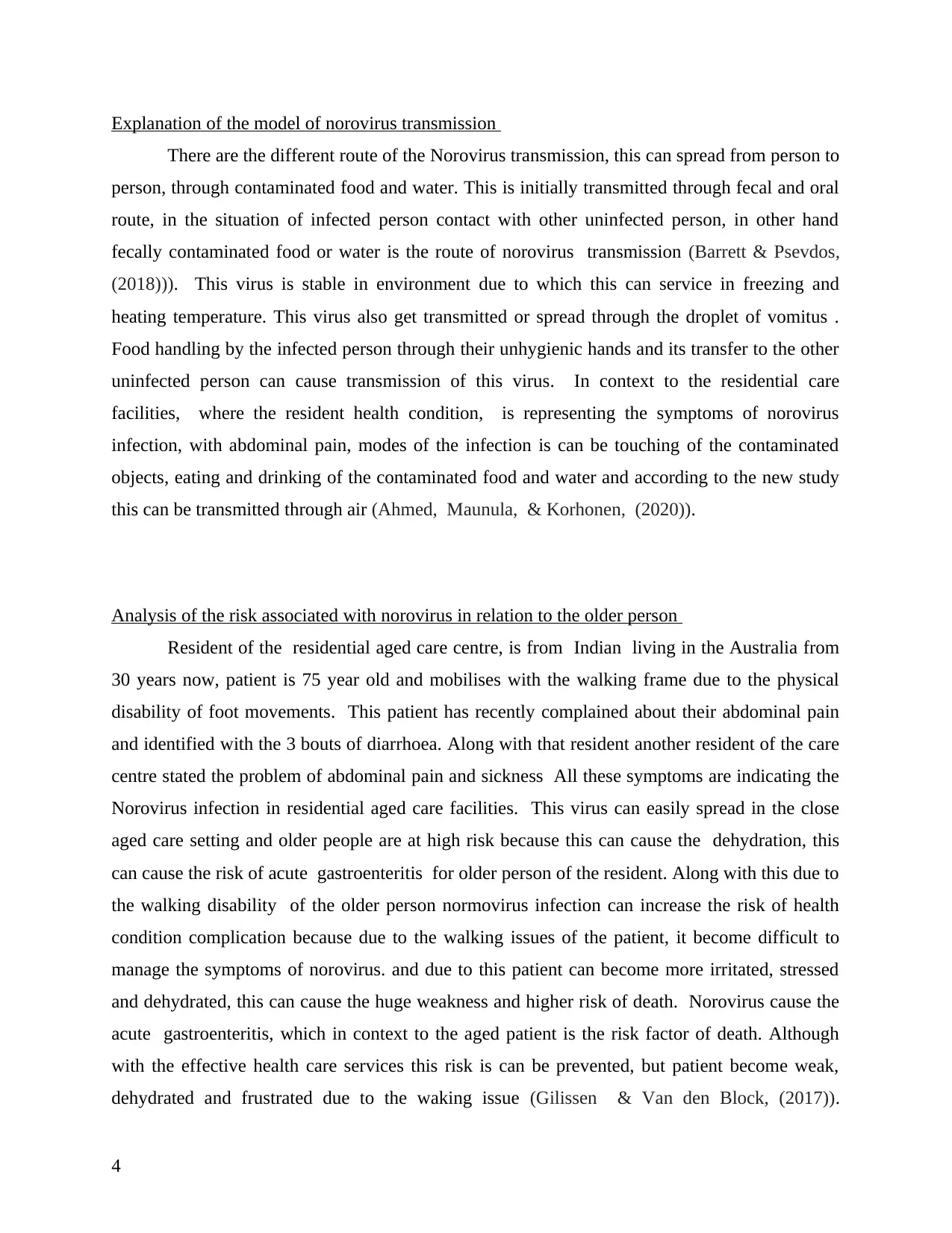
Explanation of the model of norovirus transmission
There are the different route of the Norovirus transmission, this can spread from person to
person, through contaminated food and water. This is initially transmitted through fecal and oral
route, in the situation of infected person contact with other uninfected person, in other hand
fecally contaminated food or water is the route of norovirus transmission (Barrett & Psevdos,
(2018))). This virus is stable in environment due to which this can service in freezing and
heating temperature. This virus also get transmitted or spread through the droplet of vomitus .
Food handling by the infected person through their unhygienic hands and its transfer to the other
uninfected person can cause transmission of this virus. In context to the residential care
facilities, where the resident health condition, is representing the symptoms of norovirus
infection, with abdominal pain, modes of the infection is can be touching of the contaminated
objects, eating and drinking of the contaminated food and water and according to the new study
this can be transmitted through air (Ahmed, Maunula, & Korhonen, (2020)).
Analysis of the risk associated with norovirus in relation to the older person
Resident of the residential aged care centre, is from Indian living in the Australia from
30 years now, patient is 75 year old and mobilises with the walking frame due to the physical
disability of foot movements. This patient has recently complained about their abdominal pain
and identified with the 3 bouts of diarrhoea. Along with that resident another resident of the care
centre stated the problem of abdominal pain and sickness All these symptoms are indicating the
Norovirus infection in residential aged care facilities. This virus can easily spread in the close
aged care setting and older people are at high risk because this can cause the dehydration, this
can cause the risk of acute gastroenteritis for older person of the resident. Along with this due to
the walking disability of the older person normovirus infection can increase the risk of health
condition complication because due to the walking issues of the patient, it become difficult to
manage the symptoms of norovirus. and due to this patient can become more irritated, stressed
and dehydrated, this can cause the huge weakness and higher risk of death. Norovirus cause the
acute gastroenteritis, which in context to the aged patient is the risk factor of death. Although
with the effective health care services this risk is can be prevented, but patient become weak,
dehydrated and frustrated due to the waking issue (Gilissen & Van den Block, (2017)).
4
There are the different route of the Norovirus transmission, this can spread from person to
person, through contaminated food and water. This is initially transmitted through fecal and oral
route, in the situation of infected person contact with other uninfected person, in other hand
fecally contaminated food or water is the route of norovirus transmission (Barrett & Psevdos,
(2018))). This virus is stable in environment due to which this can service in freezing and
heating temperature. This virus also get transmitted or spread through the droplet of vomitus .
Food handling by the infected person through their unhygienic hands and its transfer to the other
uninfected person can cause transmission of this virus. In context to the residential care
facilities, where the resident health condition, is representing the symptoms of norovirus
infection, with abdominal pain, modes of the infection is can be touching of the contaminated
objects, eating and drinking of the contaminated food and water and according to the new study
this can be transmitted through air (Ahmed, Maunula, & Korhonen, (2020)).
Analysis of the risk associated with norovirus in relation to the older person
Resident of the residential aged care centre, is from Indian living in the Australia from
30 years now, patient is 75 year old and mobilises with the walking frame due to the physical
disability of foot movements. This patient has recently complained about their abdominal pain
and identified with the 3 bouts of diarrhoea. Along with that resident another resident of the care
centre stated the problem of abdominal pain and sickness All these symptoms are indicating the
Norovirus infection in residential aged care facilities. This virus can easily spread in the close
aged care setting and older people are at high risk because this can cause the dehydration, this
can cause the risk of acute gastroenteritis for older person of the resident. Along with this due to
the walking disability of the older person normovirus infection can increase the risk of health
condition complication because due to the walking issues of the patient, it become difficult to
manage the symptoms of norovirus. and due to this patient can become more irritated, stressed
and dehydrated, this can cause the huge weakness and higher risk of death. Norovirus cause the
acute gastroenteritis, which in context to the aged patient is the risk factor of death. Although
with the effective health care services this risk is can be prevented, but patient become weak,
dehydrated and frustrated due to the waking issue (Gilissen & Van den Block, (2017)).
4
Paraphrase This Document
Need a fresh take? Get an instant paraphrase of this document with our AI Paraphraser
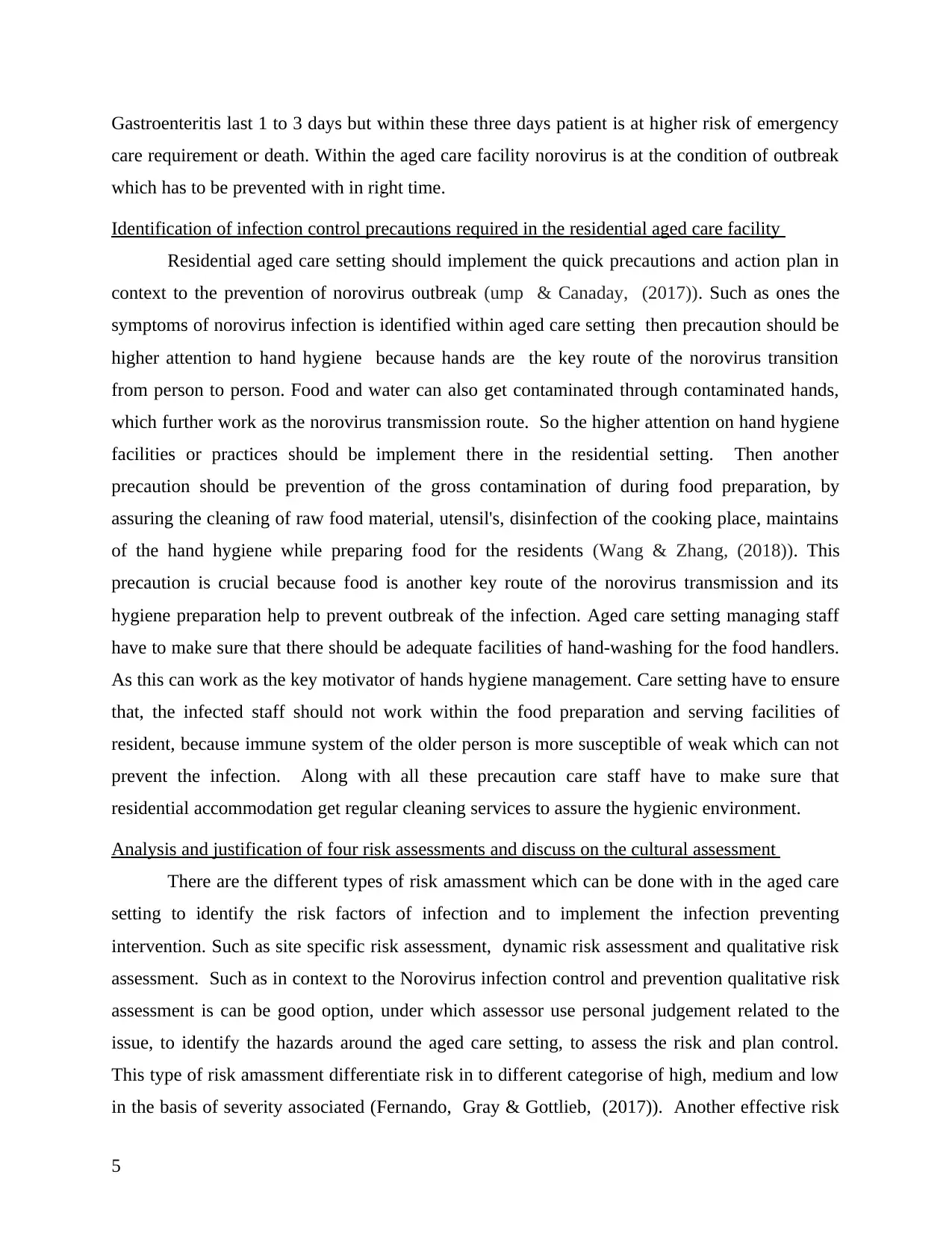
Gastroenteritis last 1 to 3 days but within these three days patient is at higher risk of emergency
care requirement or death. Within the aged care facility norovirus is at the condition of outbreak
which has to be prevented with in right time.
Identification of infection control precautions required in the residential aged care facility
Residential aged care setting should implement the quick precautions and action plan in
context to the prevention of norovirus outbreak (ump & Canaday, (2017)). Such as ones the
symptoms of norovirus infection is identified within aged care setting then precaution should be
higher attention to hand hygiene because hands are the key route of the norovirus transition
from person to person. Food and water can also get contaminated through contaminated hands,
which further work as the norovirus transmission route. So the higher attention on hand hygiene
facilities or practices should be implement there in the residential setting. Then another
precaution should be prevention of the gross contamination of during food preparation, by
assuring the cleaning of raw food material, utensil's, disinfection of the cooking place, maintains
of the hand hygiene while preparing food for the residents (Wang & Zhang, (2018)). This
precaution is crucial because food is another key route of the norovirus transmission and its
hygiene preparation help to prevent outbreak of the infection. Aged care setting managing staff
have to make sure that there should be adequate facilities of hand-washing for the food handlers.
As this can work as the key motivator of hands hygiene management. Care setting have to ensure
that, the infected staff should not work within the food preparation and serving facilities of
resident, because immune system of the older person is more susceptible of weak which can not
prevent the infection. Along with all these precaution care staff have to make sure that
residential accommodation get regular cleaning services to assure the hygienic environment.
Analysis and justification of four risk assessments and discuss on the cultural assessment
There are the different types of risk amassment which can be done with in the aged care
setting to identify the risk factors of infection and to implement the infection preventing
intervention. Such as site specific risk assessment, dynamic risk assessment and qualitative risk
assessment. Such as in context to the Norovirus infection control and prevention qualitative risk
assessment is can be good option, under which assessor use personal judgement related to the
issue, to identify the hazards around the aged care setting, to assess the risk and plan control.
This type of risk amassment differentiate risk in to different categorise of high, medium and low
in the basis of severity associated (Fernando, Gray & Gottlieb, (2017)). Another effective risk
5
care requirement or death. Within the aged care facility norovirus is at the condition of outbreak
which has to be prevented with in right time.
Identification of infection control precautions required in the residential aged care facility
Residential aged care setting should implement the quick precautions and action plan in
context to the prevention of norovirus outbreak (ump & Canaday, (2017)). Such as ones the
symptoms of norovirus infection is identified within aged care setting then precaution should be
higher attention to hand hygiene because hands are the key route of the norovirus transition
from person to person. Food and water can also get contaminated through contaminated hands,
which further work as the norovirus transmission route. So the higher attention on hand hygiene
facilities or practices should be implement there in the residential setting. Then another
precaution should be prevention of the gross contamination of during food preparation, by
assuring the cleaning of raw food material, utensil's, disinfection of the cooking place, maintains
of the hand hygiene while preparing food for the residents (Wang & Zhang, (2018)). This
precaution is crucial because food is another key route of the norovirus transmission and its
hygiene preparation help to prevent outbreak of the infection. Aged care setting managing staff
have to make sure that there should be adequate facilities of hand-washing for the food handlers.
As this can work as the key motivator of hands hygiene management. Care setting have to ensure
that, the infected staff should not work within the food preparation and serving facilities of
resident, because immune system of the older person is more susceptible of weak which can not
prevent the infection. Along with all these precaution care staff have to make sure that
residential accommodation get regular cleaning services to assure the hygienic environment.
Analysis and justification of four risk assessments and discuss on the cultural assessment
There are the different types of risk amassment which can be done with in the aged care
setting to identify the risk factors of infection and to implement the infection preventing
intervention. Such as site specific risk assessment, dynamic risk assessment and qualitative risk
assessment. Such as in context to the Norovirus infection control and prevention qualitative risk
assessment is can be good option, under which assessor use personal judgement related to the
issue, to identify the hazards around the aged care setting, to assess the risk and plan control.
This type of risk amassment differentiate risk in to different categorise of high, medium and low
in the basis of severity associated (Fernando, Gray & Gottlieb, (2017)). Another effective risk
5
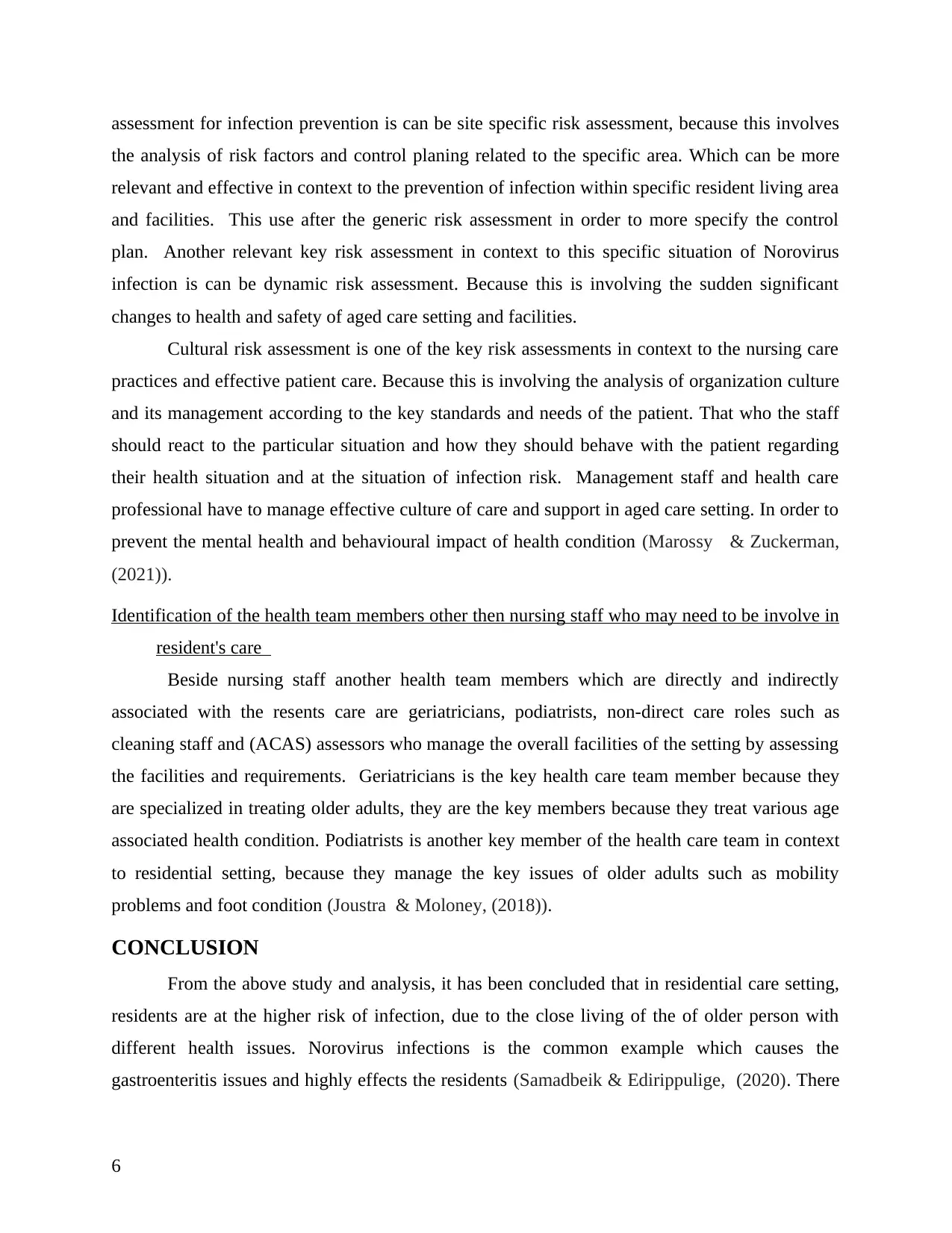
assessment for infection prevention is can be site specific risk assessment, because this involves
the analysis of risk factors and control planing related to the specific area. Which can be more
relevant and effective in context to the prevention of infection within specific resident living area
and facilities. This use after the generic risk assessment in order to more specify the control
plan. Another relevant key risk assessment in context to this specific situation of Norovirus
infection is can be dynamic risk assessment. Because this is involving the sudden significant
changes to health and safety of aged care setting and facilities.
Cultural risk assessment is one of the key risk assessments in context to the nursing care
practices and effective patient care. Because this is involving the analysis of organization culture
and its management according to the key standards and needs of the patient. That who the staff
should react to the particular situation and how they should behave with the patient regarding
their health situation and at the situation of infection risk. Management staff and health care
professional have to manage effective culture of care and support in aged care setting. In order to
prevent the mental health and behavioural impact of health condition (Marossy & Zuckerman,
(2021)).
Identification of the health team members other then nursing staff who may need to be involve in
resident's care
Beside nursing staff another health team members which are directly and indirectly
associated with the resents care are geriatricians, podiatrists, non-direct care roles such as
cleaning staff and (ACAS) assessors who manage the overall facilities of the setting by assessing
the facilities and requirements. Geriatricians is the key health care team member because they
are specialized in treating older adults, they are the key members because they treat various age
associated health condition. Podiatrists is another key member of the health care team in context
to residential setting, because they manage the key issues of older adults such as mobility
problems and foot condition (Joustra & Moloney, (2018)).
CONCLUSION
From the above study and analysis, it has been concluded that in residential care setting,
residents are at the higher risk of infection, due to the close living of the of older person with
different health issues. Norovirus infections is the common example which causes the
gastroenteritis issues and highly effects the residents (Samadbeik & Edirippulige, (2020). There
6
the analysis of risk factors and control planing related to the specific area. Which can be more
relevant and effective in context to the prevention of infection within specific resident living area
and facilities. This use after the generic risk assessment in order to more specify the control
plan. Another relevant key risk assessment in context to this specific situation of Norovirus
infection is can be dynamic risk assessment. Because this is involving the sudden significant
changes to health and safety of aged care setting and facilities.
Cultural risk assessment is one of the key risk assessments in context to the nursing care
practices and effective patient care. Because this is involving the analysis of organization culture
and its management according to the key standards and needs of the patient. That who the staff
should react to the particular situation and how they should behave with the patient regarding
their health situation and at the situation of infection risk. Management staff and health care
professional have to manage effective culture of care and support in aged care setting. In order to
prevent the mental health and behavioural impact of health condition (Marossy & Zuckerman,
(2021)).
Identification of the health team members other then nursing staff who may need to be involve in
resident's care
Beside nursing staff another health team members which are directly and indirectly
associated with the resents care are geriatricians, podiatrists, non-direct care roles such as
cleaning staff and (ACAS) assessors who manage the overall facilities of the setting by assessing
the facilities and requirements. Geriatricians is the key health care team member because they
are specialized in treating older adults, they are the key members because they treat various age
associated health condition. Podiatrists is another key member of the health care team in context
to residential setting, because they manage the key issues of older adults such as mobility
problems and foot condition (Joustra & Moloney, (2018)).
CONCLUSION
From the above study and analysis, it has been concluded that in residential care setting,
residents are at the higher risk of infection, due to the close living of the of older person with
different health issues. Norovirus infections is the common example which causes the
gastroenteritis issues and highly effects the residents (Samadbeik & Edirippulige, (2020). There
6
⊘ This is a preview!⊘
Do you want full access?
Subscribe today to unlock all pages.

Trusted by 1+ million students worldwide
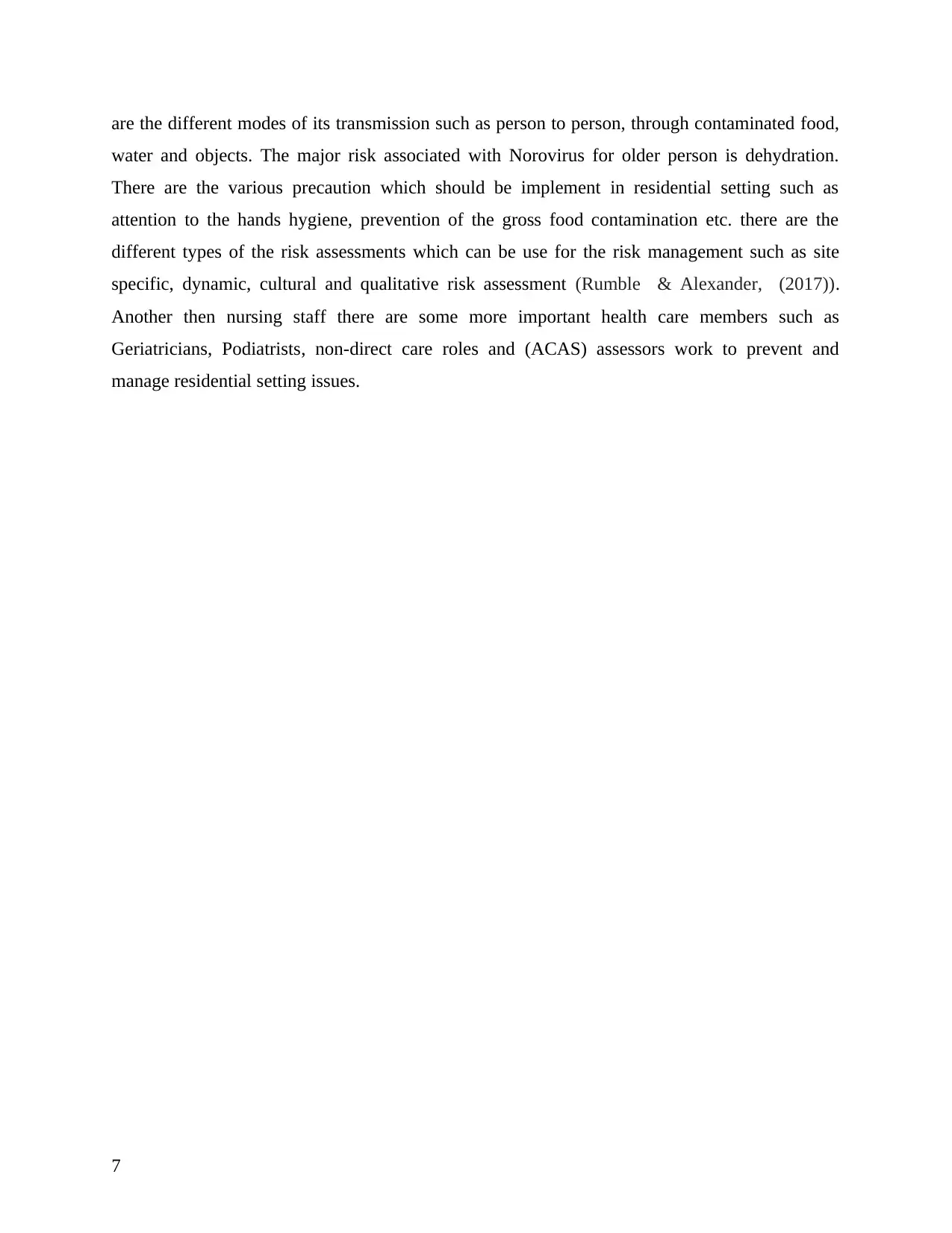
are the different modes of its transmission such as person to person, through contaminated food,
water and objects. The major risk associated with Norovirus for older person is dehydration.
There are the various precaution which should be implement in residential setting such as
attention to the hands hygiene, prevention of the gross food contamination etc. there are the
different types of the risk assessments which can be use for the risk management such as site
specific, dynamic, cultural and qualitative risk assessment (Rumble & Alexander, (2017)).
Another then nursing staff there are some more important health care members such as
Geriatricians, Podiatrists, non-direct care roles and (ACAS) assessors work to prevent and
manage residential setting issues.
7
water and objects. The major risk associated with Norovirus for older person is dehydration.
There are the various precaution which should be implement in residential setting such as
attention to the hands hygiene, prevention of the gross food contamination etc. there are the
different types of the risk assessments which can be use for the risk management such as site
specific, dynamic, cultural and qualitative risk assessment (Rumble & Alexander, (2017)).
Another then nursing staff there are some more important health care members such as
Geriatricians, Podiatrists, non-direct care roles and (ACAS) assessors work to prevent and
manage residential setting issues.
7
Paraphrase This Document
Need a fresh take? Get an instant paraphrase of this document with our AI Paraphraser
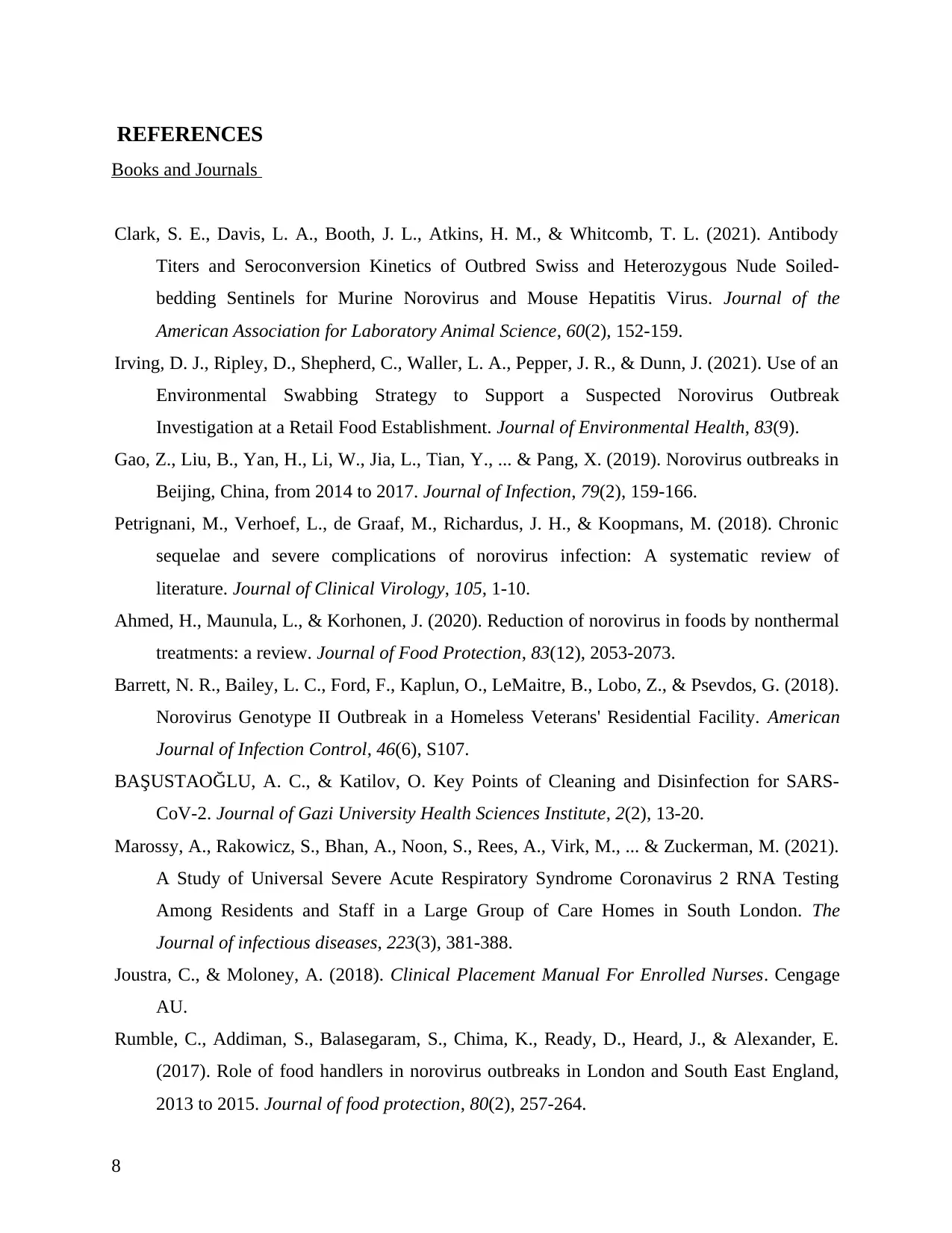
REFERENCES
Books and Journals
Clark, S. E., Davis, L. A., Booth, J. L., Atkins, H. M., & Whitcomb, T. L. (2021). Antibody
Titers and Seroconversion Kinetics of Outbred Swiss and Heterozygous Nude Soiled-
bedding Sentinels for Murine Norovirus and Mouse Hepatitis Virus. Journal of the
American Association for Laboratory Animal Science, 60(2), 152-159.
Irving, D. J., Ripley, D., Shepherd, C., Waller, L. A., Pepper, J. R., & Dunn, J. (2021). Use of an
Environmental Swabbing Strategy to Support a Suspected Norovirus Outbreak
Investigation at a Retail Food Establishment. Journal of Environmental Health, 83(9).
Gao, Z., Liu, B., Yan, H., Li, W., Jia, L., Tian, Y., ... & Pang, X. (2019). Norovirus outbreaks in
Beijing, China, from 2014 to 2017. Journal of Infection, 79(2), 159-166.
Petrignani, M., Verhoef, L., de Graaf, M., Richardus, J. H., & Koopmans, M. (2018). Chronic
sequelae and severe complications of norovirus infection: A systematic review of
literature. Journal of Clinical Virology, 105, 1-10.
Ahmed, H., Maunula, L., & Korhonen, J. (2020). Reduction of norovirus in foods by nonthermal
treatments: a review. Journal of Food Protection, 83(12), 2053-2073.
Barrett, N. R., Bailey, L. C., Ford, F., Kaplun, O., LeMaitre, B., Lobo, Z., & Psevdos, G. (2018).
Norovirus Genotype II Outbreak in a Homeless Veterans' Residential Facility. American
Journal of Infection Control, 46(6), S107.
BAŞUSTAOĞLU, A. C., & Katilov, O. Key Points of Cleaning and Disinfection for SARS-
CoV-2. Journal of Gazi University Health Sciences Institute, 2(2), 13-20.
Marossy, A., Rakowicz, S., Bhan, A., Noon, S., Rees, A., Virk, M., ... & Zuckerman, M. (2021).
A Study of Universal Severe Acute Respiratory Syndrome Coronavirus 2 RNA Testing
Among Residents and Staff in a Large Group of Care Homes in South London. The
Journal of infectious diseases, 223(3), 381-388.
Joustra, C., & Moloney, A. (2018). Clinical Placement Manual For Enrolled Nurses. Cengage
AU.
Rumble, C., Addiman, S., Balasegaram, S., Chima, K., Ready, D., Heard, J., & Alexander, E.
(2017). Role of food handlers in norovirus outbreaks in London and South East England,
2013 to 2015. Journal of food protection, 80(2), 257-264.
8
Books and Journals
Clark, S. E., Davis, L. A., Booth, J. L., Atkins, H. M., & Whitcomb, T. L. (2021). Antibody
Titers and Seroconversion Kinetics of Outbred Swiss and Heterozygous Nude Soiled-
bedding Sentinels for Murine Norovirus and Mouse Hepatitis Virus. Journal of the
American Association for Laboratory Animal Science, 60(2), 152-159.
Irving, D. J., Ripley, D., Shepherd, C., Waller, L. A., Pepper, J. R., & Dunn, J. (2021). Use of an
Environmental Swabbing Strategy to Support a Suspected Norovirus Outbreak
Investigation at a Retail Food Establishment. Journal of Environmental Health, 83(9).
Gao, Z., Liu, B., Yan, H., Li, W., Jia, L., Tian, Y., ... & Pang, X. (2019). Norovirus outbreaks in
Beijing, China, from 2014 to 2017. Journal of Infection, 79(2), 159-166.
Petrignani, M., Verhoef, L., de Graaf, M., Richardus, J. H., & Koopmans, M. (2018). Chronic
sequelae and severe complications of norovirus infection: A systematic review of
literature. Journal of Clinical Virology, 105, 1-10.
Ahmed, H., Maunula, L., & Korhonen, J. (2020). Reduction of norovirus in foods by nonthermal
treatments: a review. Journal of Food Protection, 83(12), 2053-2073.
Barrett, N. R., Bailey, L. C., Ford, F., Kaplun, O., LeMaitre, B., Lobo, Z., & Psevdos, G. (2018).
Norovirus Genotype II Outbreak in a Homeless Veterans' Residential Facility. American
Journal of Infection Control, 46(6), S107.
BAŞUSTAOĞLU, A. C., & Katilov, O. Key Points of Cleaning and Disinfection for SARS-
CoV-2. Journal of Gazi University Health Sciences Institute, 2(2), 13-20.
Marossy, A., Rakowicz, S., Bhan, A., Noon, S., Rees, A., Virk, M., ... & Zuckerman, M. (2021).
A Study of Universal Severe Acute Respiratory Syndrome Coronavirus 2 RNA Testing
Among Residents and Staff in a Large Group of Care Homes in South London. The
Journal of infectious diseases, 223(3), 381-388.
Joustra, C., & Moloney, A. (2018). Clinical Placement Manual For Enrolled Nurses. Cengage
AU.
Rumble, C., Addiman, S., Balasegaram, S., Chima, K., Ready, D., Heard, J., & Alexander, E.
(2017). Role of food handlers in norovirus outbreaks in London and South East England,
2013 to 2015. Journal of food protection, 80(2), 257-264.
8
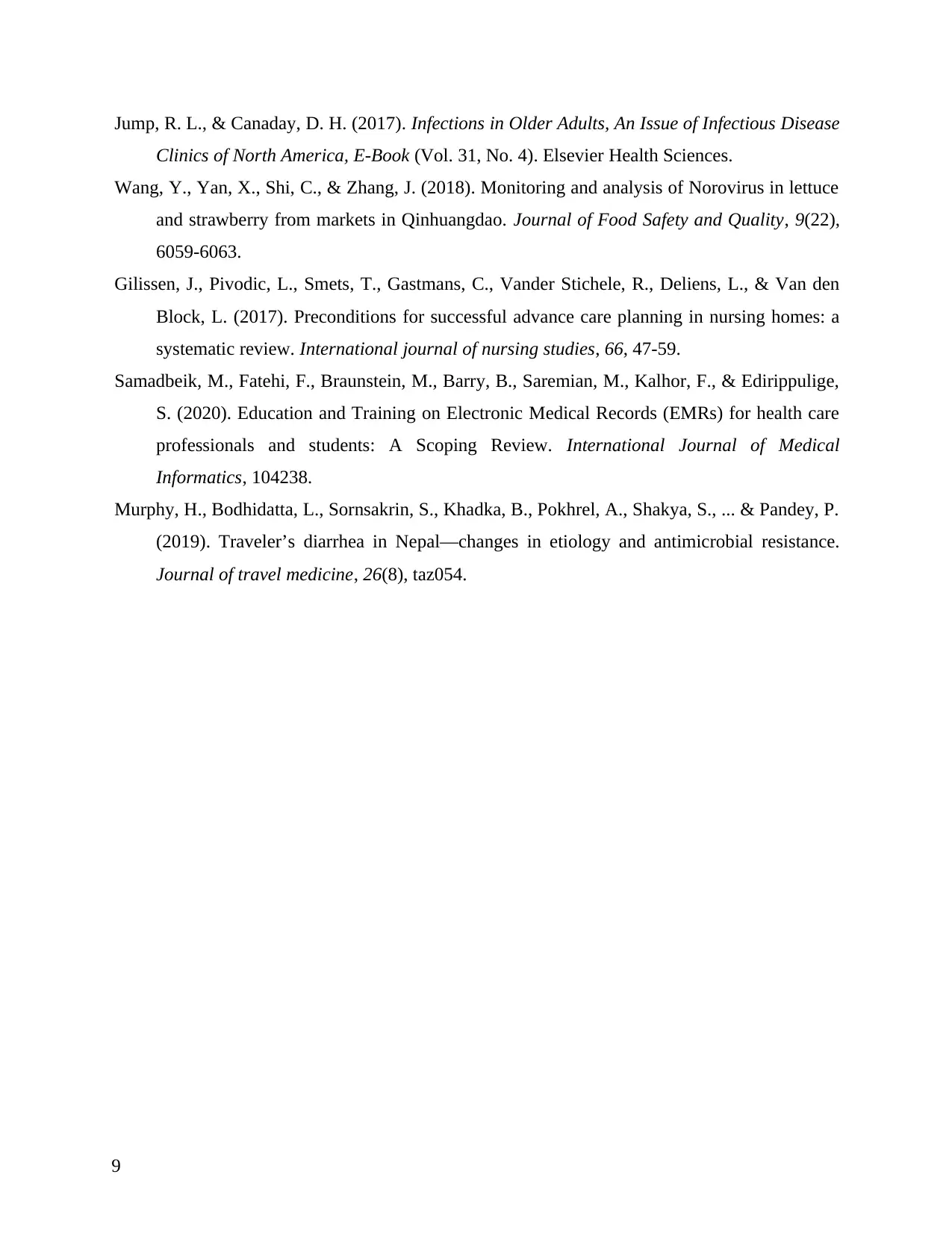
Jump, R. L., & Canaday, D. H. (2017). Infections in Older Adults, An Issue of Infectious Disease
Clinics of North America, E-Book (Vol. 31, No. 4). Elsevier Health Sciences.
Wang, Y., Yan, X., Shi, C., & Zhang, J. (2018). Monitoring and analysis of Norovirus in lettuce
and strawberry from markets in Qinhuangdao. Journal of Food Safety and Quality, 9(22),
6059-6063.
Gilissen, J., Pivodic, L., Smets, T., Gastmans, C., Vander Stichele, R., Deliens, L., & Van den
Block, L. (2017). Preconditions for successful advance care planning in nursing homes: a
systematic review. International journal of nursing studies, 66, 47-59.
Samadbeik, M., Fatehi, F., Braunstein, M., Barry, B., Saremian, M., Kalhor, F., & Edirippulige,
S. (2020). Education and Training on Electronic Medical Records (EMRs) for health care
professionals and students: A Scoping Review. International Journal of Medical
Informatics, 104238.
Murphy, H., Bodhidatta, L., Sornsakrin, S., Khadka, B., Pokhrel, A., Shakya, S., ... & Pandey, P.
(2019). Traveler’s diarrhea in Nepal—changes in etiology and antimicrobial resistance.
Journal of travel medicine, 26(8), taz054.
9
Clinics of North America, E-Book (Vol. 31, No. 4). Elsevier Health Sciences.
Wang, Y., Yan, X., Shi, C., & Zhang, J. (2018). Monitoring and analysis of Norovirus in lettuce
and strawberry from markets in Qinhuangdao. Journal of Food Safety and Quality, 9(22),
6059-6063.
Gilissen, J., Pivodic, L., Smets, T., Gastmans, C., Vander Stichele, R., Deliens, L., & Van den
Block, L. (2017). Preconditions for successful advance care planning in nursing homes: a
systematic review. International journal of nursing studies, 66, 47-59.
Samadbeik, M., Fatehi, F., Braunstein, M., Barry, B., Saremian, M., Kalhor, F., & Edirippulige,
S. (2020). Education and Training on Electronic Medical Records (EMRs) for health care
professionals and students: A Scoping Review. International Journal of Medical
Informatics, 104238.
Murphy, H., Bodhidatta, L., Sornsakrin, S., Khadka, B., Pokhrel, A., Shakya, S., ... & Pandey, P.
(2019). Traveler’s diarrhea in Nepal—changes in etiology and antimicrobial resistance.
Journal of travel medicine, 26(8), taz054.
9
⊘ This is a preview!⊘
Do you want full access?
Subscribe today to unlock all pages.

Trusted by 1+ million students worldwide

10
1 out of 10
Related Documents
Your All-in-One AI-Powered Toolkit for Academic Success.
+13062052269
info@desklib.com
Available 24*7 on WhatsApp / Email
![[object Object]](/_next/static/media/star-bottom.7253800d.svg)
Unlock your academic potential
Copyright © 2020–2025 A2Z Services. All Rights Reserved. Developed and managed by ZUCOL.




